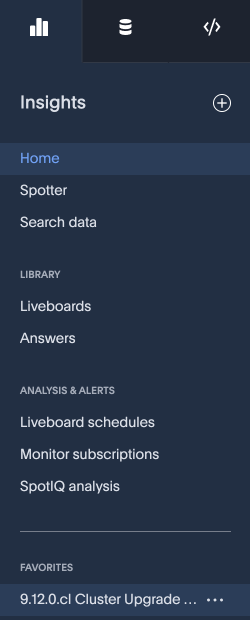What’s coming in the next release
The following features are coming in the next release of ThoughtSpot Cloud.
October 2025 10.13.0.cl
| Features marked as Beta are off by default. To enable them, contact ThoughtSpot support. |
Navigation and favorites Early Access
ThoughtSpot introduces navigation organized by persona. The new navigation allows business users, analysts, data engineers, administrators, and developers to work in separate contextual sections designed specifically for their needs. In addition, Favorites have been added to the left panel navigation Insights tab. To enable this feature, contact your administrator.

List page
ThoughtSpot introduces improved list pages. List pages include improved sorting, filtering, tags and views. List pages also now remember selections for All and Yours, and allow you to see Favorites and Verified with one click.
Forecasting
Forecasting is now available to all users and on by default. You can use SpotIQ analysis to forecast future trends for your KPIs. ThoughtSpot uses machine learning models that learn from past trends, growth, and seasonality to project how the target metric will trend in the future.
This feature can be disabled from the Search & SpotIQ option under Application Settings on the Admin settings page.
Enhanced dynamic parameters in charts
Enhanced dynamic parameters are now available to all users and on by default. You can use any parameter from an axis or column name of a chart in the title or description of the Answer which contains that chart. A parameter used in the title or description always displays the value of the same parameter used in the chart itself.
Emails for failed scheduled jobs Early Access
The creator of a scheduled job now gets an email alert if the job fails to send to any number of subscribers to the job. To enable this feature, contact ThoughtSpot support.
Number formatting for Japanese
We have updated the abbreviations for large number formatting in Japanese. Our new format uses 千 for thousands, 百万 for millions, 十億 for billions, and 兆 for trillions.
Add groups as subscribers to alerts
Groups can now be added as subscribers to alerts. When you want to add multiple users to an alert subscription, you can now search for their group in the alert subscription modal and add them all at once. Note that users subscribed through a group must be removed from the group to be removed from the alert schedule.
Other features and enhancements
Spotter natural language instructions Beta
You can now add natural language instructions directly to a Model in the Data workspace. For example, you can instruct Spotter to specify the date filter as the last 30 days if the user does not provide a date keyword. You can edit instructions directly in a conversation by clicking the instructions icon in Spotter. You must have edit access to a Model or administrator privileges to view and edit instructions. Instructions on a Model are limited to 3000 characters. To enable this feature, contact ThoughtSpot support.
Column security rules Early Access
You can now set column security rules at the table level, and they will automatically inherited to associated Models. Operational management is simplified as the cluster setting, Strict Object Mode, is not required. In addition, rules are only required for the secured columns rather than all columns in the table. For each column you select as restricted, you can define which group(s) can have access to the column. Users without access will not see the column in search results, or anywhere in the product. To enable this feature, contact your administrator.

Enhanced row-level security (RLS) rule logic Early Access
ThoughtSpot introduces RLS rule logic to support using AND/OR operators with bracket notation. You can now define more precise and complex access control policies that accurately reflect your organization’s security requirements without resorting to data modeling solutions with access control list tables. To enable this feature, contact your administrator.
RLS support for integer comparison for ts_groups
ThoughtSpot introduces a new system variable ts_groups_int for integer comparison in the row-level security configuration. This allows you to create RLS rules where an integer column is compared directly to the integer group IDs a user belongs to.
ClickHouse AWS PrivateLink
ThoughtSpot now supports AWS PrivateLink for ClickHouse connections. ThoughtSpot encrypts all your data by default. For an additional layer of security and network reliability, you can use an AWS PrivateLink. To enable ClickHouse connections, contact your administrator.
OAuth Client Credentials for Snowflake
We now support OAuth Client Credentials authentication for Snowflake.
Connection TML import for OAuth without validation
ThoughtSpot now supports importing OAuth connections through TML without validation. This feature allows users to import an OAuth connection via TML without performing validation during the import process.
System Cross-domain Identity Management (SCIM) support
SCIM is now available to all users and on by default. ThoughtSpot supports the use of SCIM to automate identity management and user provisioning across different identity management systems. Customers who use identity providers like Okta or Active Directory for identity management can now sync their user-management functions between their IdP and ThoughtSpot Cloud. Users are provisioned with their corresponding group and Org attributes when they authenticate via SSO (SAML). Users that are deactivated in their IDP are removed from ThoughtSpot as well.
For the Developer
For new features and enhancements introduced in this release of ThoughtSpot Embedded, see ThoughtSpot Developer Documentation.



